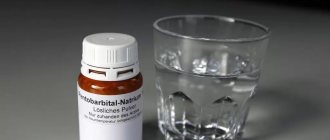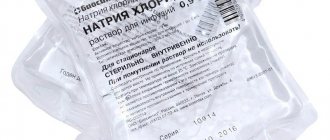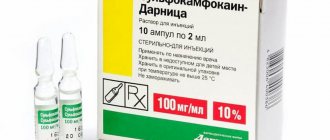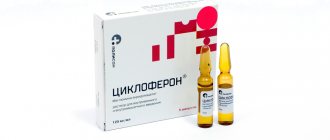Caffeine sodium benzoate, 100 mg, tablets, 6 pcs.
Psychostimulant and analeptic drug, a derivative of methylxanthine. Competitively blocks central and peripheral A1 and A2 adenosine receptors. Inhibits the activity of PDE in the central nervous system, heart, smooth muscle organs, skeletal muscles, adipose tissue, promotes the accumulation of cAMP and cGMP in them (this effect is observed when used only in high doses). Stimulates the centers of the medulla oblongata (respiratory and vasomotor), as well as the n.vagus center, has a direct stimulating effect on the cerebral cortex. In high doses, it facilitates interneuronal conduction in the spinal cord, enhancing spinal reflexes.
Increases mental and physical performance, stimulates mental activity, motor activity, shortens reaction time, temporarily reduces fatigue and drowsiness. In small doses, the stimulating effect predominates, and in large doses, the effect of depression of the nervous system predominates.
Speeds up and deepens breathing. Usually it has a positive ino-, chrono-, bathmo- and dromotropic effect (since the effect on the cardiovascular system consists of a direct stimulating effect on the myocardium and a simultaneous stimulating effect on the n.vagus centers, the resulting effect depends on the predominance of one or another action). Stimulates the vasomotor center and has a direct relaxing effect on the vascular wall, which leads to dilation of the vessels of the heart, skeletal muscles and kidneys, while the tone of the cerebral arteries increases (causes a narrowing of the blood vessels of the brain, which is accompanied by a decrease in cerebral blood flow and oxygen pressure in the brain).
Blood pressure changes under the influence of vascular and cardiac mechanisms of caffeine's influence: with normal initial blood pressure, caffeine does not change or slightly increases it; with arterial hypotension, it normalizes it.
It has an antispasmodic effect on smooth muscles (including a bronchodilator effect), and a stimulating effect on striated muscles.
Increases the secretory activity of the stomach.
It has a moderate diuretic effect, which is due to a decrease in the reabsorption of sodium and water ions in the proximal and distal renal tubules, as well as dilation of renal vessels and increased filtration in the renal glomeruli.
Reduces platelet aggregation and histamine release from mast cells.
Increases basal metabolism: increases glycogenolysis, increases lipolysis.
I. General information
1. Name of the medicinal product for veterinary use:
– trade name of the medicinal product – Caffeine-sodium benzoate 20%;
– international nonproprietary names – caffeine, sodium benzoate.
2. Dosage form: solution for injection.
1 ml of the drug contains as active ingredients: caffeine - 75 mg, sodium benzoate - 120 mg, and as excipients: sodium phosphate disubstituted 12-water, citric acid and water for injection.
3. In appearance, sodium caffeine benzoate 20% is a transparent, colorless liquid.
The shelf life of the medicinal product, subject to storage conditions in the manufacturer's closed packaging, is 3 years from the date of production, after opening the bottle - 28 days.
It is prohibited to use the medicinal product after the expiration date.
4. Sodium caffeine benzoate 20% is produced packaged in 10, 20 and 100 ml glass bottles of appropriate capacity, hermetically sealed with rubber stoppers and reinforced with aluminum caps with tamper evident clips. Each consumer package is supplied with instructions for use of the drug.
5. The medicinal product is stored in the manufacturer’s sealed packaging, separate from food and feed, in a place protected from direct sunlight at a temperature of 0°C to 25°C.
6. Sodium caffeine benzoate 20% should be kept out of the reach of children.
7. Unused medicinal product is disposed of in accordance with legal requirements.
8. Sodium caffeine benzoate 20% is available without a veterinarian's prescription.
Type of tea.
Cheap teas made from ground or crushed leaves packaged in tea bags produce a drink that contains more caffeine than tea made from whole leaves. In addition, tea made from the top young leaves and tea buds is also richer in caffeine than teas made from the “old” leaves. By the way, rolled leaves release caffeine more slowly than regular leaves. Brewing temperature.
The caffeine content in a cup of finished tea largely depends not on the type of tea, but on the method of brewing it.
For example, if you brew green tea with water that has cooled to 70-80 degrees, the caffeine content in the drink will be lower than in one brewed with boiling water, since the infusion (the amount of extractive substances released into the water) will not be too strong. A similar rule applies to black tea. Iced teas.
Sweet bottled teas also contain caffeine. It is formed when brewing tea or added additionally. On average, such drinks contain from seven to 15 mg of caffeine per 100 g.
Coffee and white teeth
Frequent consumption of coffee and coffee drinks makes tooth enamel yellow. Find out how to keep your teeth white if you can't imagine your day without a cup of coffee.
Caffeine: how much and where?
The problem of energy drink consumption is a constant topic in the media and in the medical community. A number of food industry specialists, doctors and commodity producers turned to the National Consumer Protection Fund with a request to look into this problem at an independent expert level.
Tea and coffee are the main sources of caffeine
The National Fund for the Support of Manufacturers decided to create a working group to implement the expert-analytical project “Analysis of the risks of consuming caffeine-containing food products presented on the Russian consumer market.”
The products were tested by authoritative specialists from VTsIOM and the Research Institute of Nutrition of the Russian Academy of Medical Sciences. Among other things, samples of non-alcoholic tonic drinks from the most famous brands were analyzed and evaluated.
Today, the caffeine content in so-called “energy” drinks is most strictly regulated and controlled, experts say. At the same time, other segments of caffeine-containing drinks are not regulated or standardized by the state to the proper extent. However, expertise suggests that the main sources of caffeine in food products are tea and coffee.
According to scientists from the Research Institute of Nutrition of the Russian Academy of Medical Sciences, caffeine contained in food products, drinks and medicines should be considered as a source of risks that must be assessed and taken into account.
During the study, various methods were used, including analytical chemistry (high-performance liquid chromatography), computational and statistical methods of analysis. Please note that the study was conducted using data available as of November 2013.
Where is there more caffeine?
The selection of product samples was carried out by a commission of the fund with the involvement of specialists from interested parties. The collected samples were delivered to the accredited laboratory of the Research Institute of Nutrition of the Russian Academy of Medical Sciences, where they were handed over to authorized persons for examination under an agreement with the foundation.
In accordance with the results obtained, the highest caffeine content of all the presented types of food products was found in coffee samples. Depending on the type and manufacturer, the spread of the data obtained ranged from 272 mg/l, that is, slightly more than in some types of tea, to 3105 mg/l.
Thus, latte coffee can contain 272-398 mg/kg of caffeine, and black tea can contain 244-301 mg/kg. But at the same time: Such a “heavyweight” as espresso can contain 1295-3105 mg/kg, and mate tea – only 92 mg/kg.
In general, the caffeine content in the tea samples ranged from 58 mg/L to 301 mg/L. In cocoa and hot chocolate from 37 mg/l. up to 397 mg/l.
The level of caffeine in chocolate depended on its type, milk content and other components. The amount of caffeine ranged from 103 mg/kg in milk chocolate with whole hazelnuts to 665 mg/kg in dark chocolate. You need to understand that the caffeine content in the same dark chocolate, but from different manufacturers, may vary.
Energy drinks contained the least amount of caffeine in the results. The highest caffeine content in energy drinks is 321 mg/l, and the lowest is 218.6 mg/l.
The caffeine content of the most popular carbonated soft drinks ranged from 87 mg/L to 130 mg/L.
Experts: safe level has definitely been exceeded
In parallel with determining the caffeine content in various caffeine-containing food products, at the request of the National Fund for Consumer Protection, VTsIOM conducted a survey of consumers in 131 localities in 46 constituent entities of the Russian Federation, in order to study the structure, levels and sources of caffeine consumption in the diet of certain categories of the population of the Russian Federation.
The survey involved 3,600 consumers, including 1,600 adult respondents aged 18-44 years and 2,000 teenage respondents aged 12-17 years.
As expected, tea became the most consumed caffeine-containing product among Russians. This drink is consumed by 95% of adults and 98% of adolescents aged 12-17 years. The lowest share of consumers (both adults and teenagers) is for energy drinks: 23% are teenagers 12-17 years old, 20% are adults.
The average Russian teenager (12-17 years old) drinks 916 servings of tea, 236 servings of coffee, 96 servings of cola drinks, 26 servings of energy drinks (250 ml can), consumes 103 servings of chocolate and 9 tablets of caffeine-containing medications per year.
Contrary to popular belief, the average consumption levels of energy drinks (by both adolescents and adult consumers) are noticeably lower than the consumption levels of other caffeine-containing products, experts emphasize.
The safe daily level of caffeine consumption recommended by Russian hygiene standards is 150 mg per day. As shown by the results of the analysis of caffeinated drinks, this amount of caffeine is contained in approximately two consumer servings of energy drinks (250 ml can) and two servings of coffee (medium cup).
Less than 1% of teenagers (0.6% to be exact) consume energy drinks in quantities exceeding the safe level of 2 servings (1 serving is a 250 ml can) per day. At the same time, 12.4% of teenagers (not to mention 32.4% of adults) consume more than 2 cups of coffee (which contain about 180 mg of caffeine) daily, the study found.
However, it should be noted that total caffeine intake (from all sources) for all population groups significantly exceeds the safe maximum daily intake (150 mg). The overwhelming amount of caffeine in the diet of all categories of the population (both adults and adolescents) comes from coffee and tea (more than 90%).
The average daily level of caffeine consumption in the Russian Federation is: for adults 18-44 years old - 344.9 mg, for adolescents 12-14 years old - 225.8 mg, for adolescents 15-17 years old - 256.6 mg. These levels significantly exceed the maximum level of safe daily caffeine consumption established in the Russian Federation (150 mg), although they are less than the safe level of caffeine consumption (400 mg/day) adopted abroad.
The consumer must be informed
To reduce caffeine consumption, consumers should be more actively informed about the recommended safe daily intake, experts say. It is also necessary to include warning labels such as “High caffeine content”, “Not recommended for children, pregnant women and nursing mothers, and persons sensitive to caffeine” on the labeling of all products containing a high concentration of caffeine, for example, ready-to-drink beverages with a caffeine content above 150 mg/l, packages of all types of dry coffee and tea (except decaffeinated coffee), as well as the corresponding range of menus and layouts of public catering establishments offering such products to consumers.
For reference: Caffeine is one of the most commonly consumed biologically active substances in the world and is found in common beverages (coffee, tea, soft drinks), products containing cocoa or chocolate, tonic (energy) drinks, medications, including analgesics and stimulants sold over-the-counter in dietary supplements and sports nutrition products.
Caffeine has the ability to increase blood pressure. This mainly occurs due to the so-called positive inotropic effect, that is, an increase in the strength and frequency of heart contractions. As a result, systolic blood volume (the amount of blood ejected from the ventricles in one heartbeat) increases. In addition, blood vessels narrow (though not all), which also contributes to an increase in blood pressure. Thus, caffeine has a direct effect on the cardiovascular system and increases the load on the heart.
Therefore, caffeine in large quantities should not be consumed by people suffering from hypertension or other pathologies associated with increased blood pressure. Also, the use of products containing caffeine should be approached with great caution by patients with coronary heart diseases, especially considering the fact that caffeine narrows the coronary vessels (the very vessels that feed the heart muscle and from the spasm of which myocardial infarction occurs). Since caffeine stimulates the production of gastrointestinal juice, you should not abuse drinks based on it (this also includes cocoa, cappuccino and even some types of tea) for patients with hyperacid gastritis and ulcerative processes in the stomach and duodenum. People who have decreased blood clotting should remember that caffeine impairs the aggregation activity (the ability to stick together) of platelets, which is one of the main mechanisms in stopping bleeding.
The vast majority of the adverse effects of caffeine do not occur with chronic caffeine consumption at a dose of about 150-400 mg/day. This assessment is valid for adult men and women of young and middle age. Caffeine consumption at a dose above 400 m g/day. undesirable, since in some cases it can negatively affect the human body, its cardiovascular, genitourinary, nervous systems, and gastrointestinal tract.
Ilya Yurukin
Based on materials from the National Consumer Protection Fund
What to do if you overdose on caffeine
People who lead a hectic lifestyle and have health problems are more susceptible to symptoms of caffeine overdose. If you feel unwell (for example, with a sharp increase in blood pressure, high heart rate and dizziness) due to excessive consumption of caffeine-containing drinks, you must provide first aid and call a doctor.
To avoid possible death, you need to know what to do if you overdose on caffeine. We also advise you not to neglect calling a doctor, since at first glance, a slight deterioration in health may be a signal of a serious disruption in the functioning of the cardiovascular system.
Treatment of caffeine overdose
If possible, have someone nearby and follow the guidelines for treating caffeine overdose until doctors arrive:
- loosen your tie and/or belt;
- loosen tight clothing;
- open a window or go out into the fresh air;
- drink clean water until completely saturated;
- do not hold back your gag reflex.
Further treatment of caffeine overdose will be carried out by doctors. If the current state of health upon examination raises concerns among physicians, treatment of caffeine overdose will need to be performed in a medical facility. It may include gastric lavage, intravenous administration of magnesium sulfate, diprazine and morphine hydrochloride, as well as drugs to reduce agitation and normalize the functioning of internal organs. In severe cases, plasma substitutes are used to treat caffeine overdose.
Rice. 2. The ratio of patients with pathology of the cardiovascular system per 100 thousand population in the Russian Federation (according to Rosstat).
What determines the caffeine content in tea?
There is no caffeine-free tea.
Coffee can be completely freed from this substance.
However, any type of real tea, both black and green, will contain caffeine. Type of tea.
Varieties of teas vary in caffeine content. Black teas contain the most of this substance: a 200 g cup contains from 60 to 85 mg of caffeine. White teas confidently occupy second place: a cup of the same volume contains up to 75 mg of this substance. A cup of regular green tea contains 30 to 60 mg of caffeine.
What determines the caffeine content in coffee?
Type of coffee.
Robusta coffee, which is used in instant coffees, contains twice as much caffeine as Arabica coffee, the most common type of coffee bean on the world market.
Thus, a cup of Robusta espresso with a volume of about 170 g contains up to 200 mg of caffeine. A similar cup of Arabica contains about 110 mg. Roasting.
Many people believe that dark roast coffee is stronger because it has a more pronounced taste and aroma.
However, heavily roasted beans contain less caffeine because prolonged processing at high temperatures breaks down the caffeine molecules. Grinding
Different methods of preparing coffee require different degrees of grinding of the coffee beans.
For example, to make Turkish coffee you need to grind the coffee almost into dust, but for a drip coffee maker or press the coffee is ground quite coarsely. Please note that the finer the coffee grind, the more caffeine will be in the finished product, since the substances contained in small particles are more easily washed out with water. Cooking time.
The longer the coffee is brewed, the higher the caffeine level it will contain. For example, coffee from a press brewed over a long period of time contains more caffeine than coffee brewed instantly using ristretto steam.




